
This page describes instruments and facilities provided by the Center for Cell Dynamics available to all Center participants. The Center is part of the Friday Harbor Labs (FHL), which provides and supports extensive additional resources.
The Center occupies a brand-new building on the FHL campus; "Lab X" constitutes approx. 4400 ft2 of research space in two stories, including an open-plan general lab, conference room, seawater room, microscope suite, and cooled computer server facility. The Center is right in the middle of the beautiful FHL campus, and looks south to the Olympic Mountains across the harbor and town. We moved into Lab X in April 2004, and somehow, in the few brief moments between our lab warming party and the inconceivable clutter of the move, Garry managed to catch a few photos of the pristine new building!
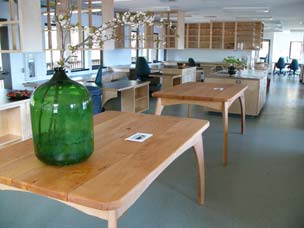
|

|
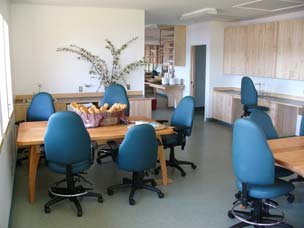
|
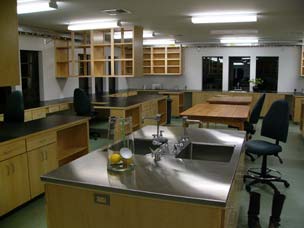
|
The Center presently operates two confocal microscopes. One is a conventional laser-scanning model (BioRad Radiance 2000) mounted on a Nikon E800 upright microscope, and the other is a spinning-disc system based on Atto's CARV module and a Nikon TE2000 inverted microscope. Both systems are equipped with the finest of Nikon's lenses: the Radiance system has a Plan Apo 20x 0.75, Plan Apo 40x 0.95, Plan Fluor 40x 0.8 water-dipping, Plan Fluor 40x 1.3 oil, and Plan Apo 60x 1.4; the CARV system has a Plan Apo 10x 0.45, Plan Fluor 20x 0.75 multi-immersion, Plan Fluor 40x 1.3 oil, Plan Apo 60x 1.4, Plan Apo 60x 1.2 water-immersion, and Plan Apo 100x 1.4. The CARV system has both oil- and water-immersion DIC condensers in addition to a conventional long-working-distance DIC condenser. The Radiance system uses a Krypton/Argon laser for 488- and 568-nm illumination, and a red diode laser for 633 nm. The CARV system uses an arc lamp and shutter wheels for illumination, allowing one virtually unlimited choice of fluorophore. It uses a Hamamatsu ORCA ER 1394 camera and is run by MetaMorph. A third confocal system, FHL's aging but still fully functional BioRad MRC-600, is currently maintained by the Center. This system is based on an older-model (non-infinity-corrected) Nikon inverted microscope with a standard set of objectives including a Plan Apo 60x 1.4 oil. We will soon have another MRC-600 operational, and expect to acquire second spinning-disc system in the near future. The DeltaVision RT deconvolution microscope is equipped with a fully automated nano-position stage, standard and fluorescent protein filter sets, repeatable stage holder, mercury lamp with a fiber optic scrambler and neutral density filters, and 410nm and 488nm lasers and analysis software for photokinetic experiments (FRAP and photoactivation), all within an environmental chamber for maintaining cells at physiological temperatures. An additional complete Linux station is available for 3-D deconvolution image processing and analysis.
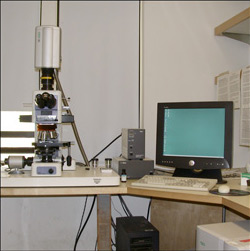
|
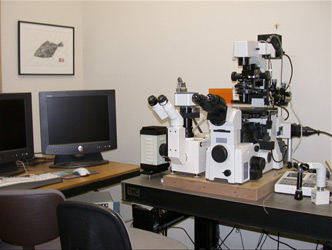
|
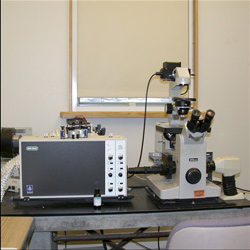
|
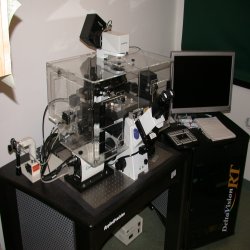
|
Confocal microscopes available to Center researchers at FHL: the Center's BioRad Radiance 2000 (top left); the Center's CARV spinning disc system (top right); FHL's BioRad MRC-600 (bottom left); the Center's Delta Vision live-cell microscopy imaging systems (bottom right).
The Center also owns several other microscopes: a Nikon SMZ-1500 epi-fluorescent dissecting microscope; two Zeiss WL Standards, one encased in a cooled box for time-lapse recording of marine invertebrates, with water immersion lenses and DIC optics; a Nikon E600 DIC/epifluorescence microscope for general use (shared with other labs at FHL); several other microscopes for individual use or set up for microinjection. We maintain a keen enthusiasm for optics and are always eager to learn new ways to shape light to show us the insides of cells!
We recently replaced FHL's vintage transmission electron microscope with a mid-80's era Phillips 420, thanks to the generosity of the UW Dept. of Biostructure and the diligent efforts of the Center's alumni imaging specialist Paulette Brunner.
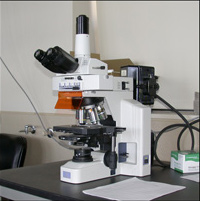
|
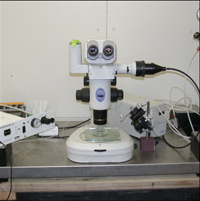
|
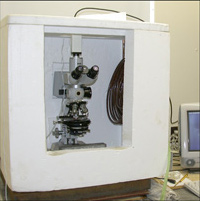
|
A few of our other research microscopes: a Nikon E600 DIC/epi-fluorescence scope shared with other FHL researchers (left); a Nikon SMZ-1500 epi-fluorescent stereo-zoom scope with microinjection equipment (middle); a Zeiss WL DIC standard in a chilled box (right).
The Center's resident scientists Paulette Brunner and George von Dassow maintain the microscopes, train users, and are available to assist Center participants with microscopy projects.
The Center is in the process of assembling, in collaboration with other FHL researchers, a kit of equipment to support routine molecular biology including cloning, sequencing, transformation, etc. Resident Center scientists Yvonne Beckham and Howard Clarke are in charge of assembling and coordinating the Center's molecular biology resources and assisting resident and visiting researchers with their projects. The Center has PCR machines, centrifuges, gel documentation equipment, incubators at essentially all possible temperatures between 10 and 37 C, etc.; FHL has more centrifuges including a couple of Beckman ultras, fume hoods, a sequencer, and various other machines that go "bing". We have acquired a BioRad micro-particle bombarder primarily for transformation of C. elegans , although we hope to figure out how to use it on other species as well.
The Center includes major projects on Drosophila, C. elegans, sea urchins, and other marine invertebrates. We have several incubators for culture of flies, worms, and anything else. We participate in a cooperative fly kitchen on the main campus that provides a weekly supply of fly food in bottles and vials. A lab helper makes worm plates locally. We have also installed a modest tissue culture facility with a laminar flow hood and CO2 incubator.
Anyone who works with marine invertebrates probably already knows that FHL provides access to an overwhelming diversity of animal species, and unparalleled convenience for maintenance and culture of marine invertebrates and their embryos and larvae. Most labs include running seawater aquaria. FHL maintains a small fleet of dive boats, a dive facility, and one large vessel (the 58-foot RV Centennial). George von Dassow will happily tour Center visitors through more seatables full of evocatively-named invertebrates than they could possibly remember, and (weather, time, and tide permitting) through the San Juan Island intertidal as well.

|
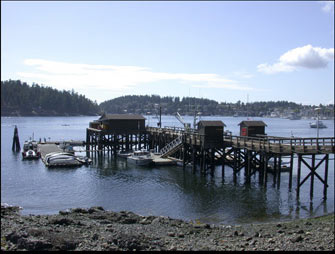
|
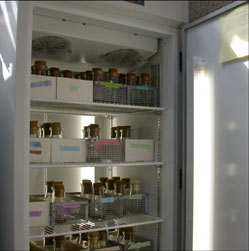
|
Brittle stars, sea cucumbers, and other invertebrates sharing a seawater table (left); the FHL dock with dive shed and boats (middle); a light-cycling fly incubator (right).
For general user-level computing, the Center provides various common-use workstations and several workstations dedicated to image processing. In addition, FHL has a campus network, including wireless access points, various models of desktop computer, printers and other ancillary equipment, and high-speed internet access.
Garry Odell, alumni research scientist Bill Sunderland, and J. Dylan Crosby (senior computer specialist extraordinaire) have assembled a distributed computing cluster to support imaging applications and computational modeling. The cluster presently includes 83 dual-CPU Intel Xeon rack-mount Servers and 77 Dual Opteron - Dual Core Dual Opteron rack-mount Servers running Linux connected by high-speed Gigabit networking to a vast 8.25 TB disk array. The current cluster is capable of greater than half a teraflop; eventually it will grow to 200 nodes (currently 464 CPU's in 160 nodes) or more as prices and space allow and as needs dictate. Once housed in the most powerful garden shed in the United States, the entire cluster has moved into Lab X where it enjoys the loving attentions of an enormous air conditioner and a 400-amp diesel generator to protect it from the vagaries of island living.
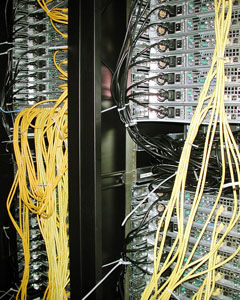
|
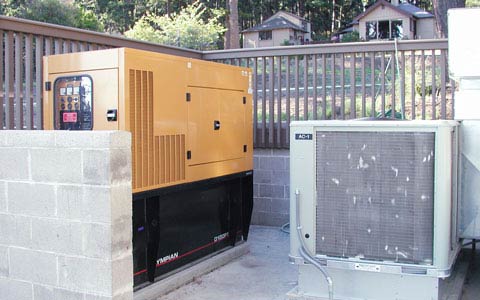
|
The back of the cluster, looking like a set piece from a Terry Gilliam movie (left); Lab X's generator and the cooling unit for the server room (right).